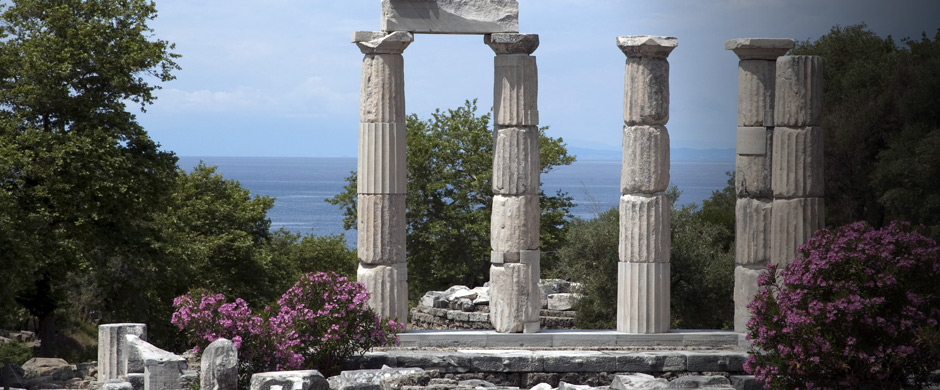 | In the Field
| In the Field

Archaeological Excavations in Samothrace, Greece
Since 1938, the Institute has worked in the Sanctuary of the Great Gods on the island of Samothrace. The Sanctuary is not only home to one of the most significant mystery cults of the Hellenistic era, but it also features the most innovative architecture of the period, gifted by Hellenistic royalty and seminal in the formation of Hellenistic and Roman architectural ideas.
We are now at work on Samothrace Volume 8,I, Monuments in the Vicinity of the Nike, which centers on the performative heart of the Sanctuary around the Theater, Stoa, and Nike Precinct. Our 2018 excavation of the theater led to an entirely new reconstruction of that building and its relationship to the Altar Court and central ravine formed by the torrent that bisects the sanctuary. Our intensive study of the 1400+ surviving building blocks of the Stoa, along with over 1000 fragments of its terracotta roof system and many more thousands of plaster fragments that document the decoration of its interior walls, have brought new insights to this building, which dominates the western plateau. In working with the Nike Monument, we continue to collaborate with colleagues at the Louvre to gain a better sense of the original situation of the statue in the Sanctuary.
In conjunction with our emphasis on passage and movement in the Sanctuary, we focused our 2019 excavations on tracing the ancient position of the central torrent and on determining how ancient visitors may have reached the Stoa. Trenches in the area of the central ravine revealed that the original position of the ancient channel was considerably to the west of the modern retaining walls. The violent collapse of the ancient Roman concrete walls that originally lined the channel was eerily reminiscent of the destruction we witnessed in the catastrophic storm that devastated the sanctuary in September 2017. To the west of the central torrent, in the dining area, we excavated the remains of a staircase that may once have led to the Stoa, but met its end in a massive collapse of boulders that once again highlighted the powerful natural forces that dominate the rugged island landscape.
In a third area, to the south of the Stoa and Nike Monument, we began research into structures that likely belong to the late Roman or early medieval period.
In all of our work, the use of 3D modeling and photogrammetry to document and reconstruct the Sanctuary digitally, in both fixed dynamic platforms, has served as a potent forensic tool to understand the powerful interconnections between landscape, architectural development, and the actions and experiences of participants in the cult.
About the team
The American team, sponsored by the Institute of Fine Arts, began its work at the Sanctuary in 1938. Except for a hiatus during World War II, work at the Sanctuary has continued ever since. The project's foundation was established in the many years of excavation and research conducted by Karl Lehmann, Phyllis Williams Lehmann, and most especially James R. McCredie, Director Emeritus of Excavations at the Sanctuary of the Great Gods, Samothrace. Bonna D. Wescoat, Professor of Art History, Emory University, is the current Director of Excavations at Samothrace. Find out more about the excavation on Emory University's website.